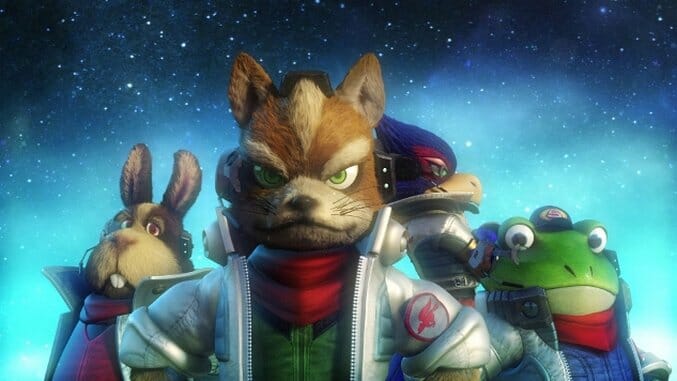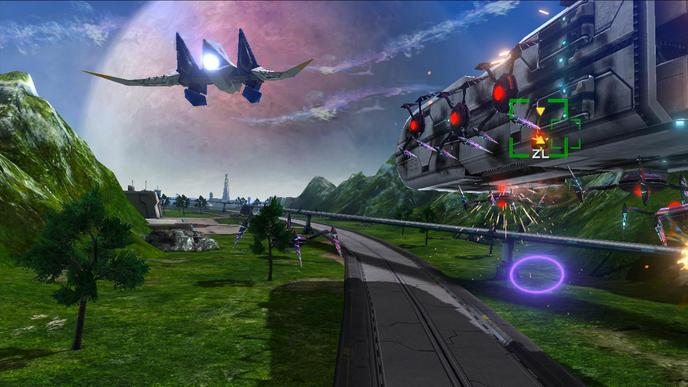
You fly over the undulating landscape, careening through valleys pocked with built-in laserguns, shooting at dive-bombing fighter jets outside your immediate vision. It’s no wonder you miss that locked door embedded in the mountainside the first five times you flew past it. You think back to past missions for clues on how to unlock the door; this is not your first space animal rodeo. Surely an entrance to another planet lies behind, a path down which new challenges await. You fly through every arch. You follow your frog squadron pilot, the one named Slippy because he’s prone to accidents. You try shooting down every enemy, an impossible task given the air is choked with them. Nothing seems to unlock this secret door hidden in plain sight.
Then you notice the top of the door glows a vicious red: Locked. The next time you fly past, you realize there’s a panel on the ground a few hundred meters earlier glowing that same red. You try shooting it: No dice. You look for the red panel elsewhere, thinking there is a sequence of targets to take down, but there’s nothing. You think: This is the first level and I can’t decipher this secret code—what else is hidden from view deeper in this world?
Then it dawns on you: Your vehicle, a space jet called an Arwing, can do something it hasn’t done in any of the many previous games under the Star Fox moniker. It can transform. As you approach the door, rolling tanks shoot at you from both sides of the glowing panel while hovering alien pods zoom in from the left. This time you pull the lever inside your cockpit and your ship malforms into what’s known as the Walker, a bipedal robot resembling a mechanized chicken. Now you’re tromping over the landscape; when your steel claw plants down on the red panel it immediately glows green: OPEN. The door in the mountainside opens. You fly through, chasing after a fellow teammate whose own ship is now wracked with giant chrome spiders. Shoot them off and a portal opens. After dozens of hollow victories, you finally found the other route in this invisible forked path. And at the end is a floating fortress that decimates you with a bevy of thick laser blasts. But it’s no matter: You’ve found its secret lair. You’ll be back.
Star Fox Zero takes its mathematical title to heart. In some ways, this is a return to the series’ roots, imagining what a Star Fox game would look like if a space shooter starring a vengeful but optimistic fox was greenlit for 2016. This is not a sequel that exists ten years after the previous game; what story there is is but another take, a parallel narrative that traces the same lines as drawn in Star Fox 64 but with newer, fresher markers.
Nintendo is nothing if not studious in its efforts to refine and iterate on its previous ideas; we see the decision time and again with most of its core franchises. And it makes sense the particular well being returned to here is the Nintendo 64 game from 1997 and not the original from four years prior; Star Fox 64 was the first Star Fox game fully developed by Nintendo (the SNES game was programmed by and based on technology from Argonaut Software, lads who would go on to form Q-Games and Vitei).
Where Star Fox was a showcase for polygonal graphics and Star Fox 64 came included with the Rumble Pak, an accessory that would popularize vibration feedback, a now-standard feature in most controllers, Star Fox Zero has the unenviable job of spotlighting the Wii U GamePad and its 6.2 inch imbedded screen. The union fits; Star Fox has always starred animals, and the expensive and misunderstood GamePad has been called an albatross around the stumbling console’s neck since day one.
Here it plays the role of Cockpit View. While the TV provides a view of your ship from behind, the GamePad offers a perspective directly from the pilot’s seat, and with a more accurate line down the gun turret’s reticule. You fly with the joysticks but you aim by moving the GamePad. The goal is to divorce your flight path from your laser-fire, giving you more agility and a chance to navigate the complex scenery while still locking onto baddies as they fly past.
At first you’re not sure where to direct your attention. Do you look at the TV and suffer from approximate aim? Or do you look at the controller and lose a sense of your surroundings? Here’s a line from my notes taken after my first play session: “I think it’ll be rewarding once you get the hang of it, but that might take…. weeks?” Fourteen days later, I’ve yet to attain mastery. But I’ve learned how to take advantage of the set-up to the point where it feels, finally, like an actual advantage and not a cumbersome, tacked-on gimmick.
If you were hoping for a grand story-rich adventure the scope of Mass Effect or Knights of the Old Republic, you have not been paying attention. For all its input and gameplay complexity, this is a stripped-down affair, heavy on replayable action and condensed down to its most unctuous bits. There are no drawn out cutscenes with over-serious space cadets; these are animals stuffed into flight gear, Maverick attitudes clashing with innocent ne’er-do-wells, and the dialogue fits. Star Fox Zero is an unashamed throwback; the pre-mission back-and-forth between General Pepper and the team takes almost every cue from the Nintendo 64 game, and doesn’t seem like it should exist in 2016. Yet here it is: a storybeat punctuated with a chipper “You can count on me!” spoken by the same voice actor, in fact, as in 1997.
And so it’s unfair to compare Star Fox Zero to those past blockbusters, or more contemporary space adventures like Eve: Valkyrie, Elite: Dangerous or even the forthcoming No Man’s Sky. But the comparison helps explain what’s so peculiar about this game, and, if you’re patient and open to its wiles, so refreshing.
To wit: I’ve just defeated the final boss and watched the credits roll. And I feel like my time with Star Fox Zero is just beginning.
You’re actively encouraged to play over and again in a number of ways: You attain gold, silver or bronze medals for high scores; you’re given free rein to choose which level you begin at the start of a new play session; once you beat the main game, another mode unlocks that further incentivizes mastery by tracking your overall time and score throughout the entire run. This is not a game designed to be beaten and forgotten.
And in this way, Star Fox Zero very much aligns with those freeform, always-on galaxies mentioned above, designed to be worlds to explore instead of levels to finish. But whereas No Many’s Sky may have, oh, a trillion more planets to explore than the spartan fifteen or so here, at some point the freedom is besides the point. Deciding to play Nintendo’s latest is a vote for design over randomness.
Repeat visits to each locale offer a deeper appreciation than what you gleaned the initial time through. The waves of enemies flying at you is not a dense, random spray; this is a curated shower of alien ships, asteroids, menacing robots and space debris. Since it doesn’t change, you can gauge your improvement. The first time I flew through Corneria, the same first planet you explore in Star Fox on SNES and Star Fox 64 on Nintendo 64, I amassed 166 hits. After defeating the last wretched menace and saving the Lylat System, I immediately ran through that first level again after honing my skills. Patterns of ships made sense for the first time; my visual vocabulary had grown over the course of my many hours with the game. Now the fast and frenetic action felt… slower. I could react. I knew better how to use the Cockpit view (sparingly). I saw a better line through the crumbling buildings and scattered laser ammo. My score that second time through: 238 hits.
Replaying grants more than just high score chasing. Just as in Star Fox 64, you can achieve certain conditions in a level or duck behind a particular obstacle and find a new, hidden path that takes you to an entirely different planet. Playing through the game once unlocked only half of the available levels. There’s essentially an entire second game waiting to be discovered.
The big question is whether you’ll want to stick around and seek out these hidden worlds. I hesitate to even focus on the control scheme, since most of the pre-release chatter has been hand-wringing over the decision to pin aiming to motion control, and there’s so much else to the game that deserves attention. (The enemy and boss design is inspired; the music is lush and anthemic; the new vehicles allow for a more varied pace and style of play; and on and on.) But the critical reticule is squarely on the GamePad and evasive action is necessary. Here we go.
This is not an intuitive design. For a game with Shigeru Miyamoto as its Supervising Director, that is a surprising statement. But it’s also not a haphazard design. This is a control scheme you learn over time. You will crash. You will be frustrated. Amateurs, in any hobby or profession, know the feeling. You know what else likely takes time to master? Flying a space-craft while manning its laser cannon.
But as you figure out the system’s limitations and you observe where and when the action on-screen requires you to be more or less accurate, you find yourself performing feats that’d be impossible without the decoupled controls. So many contemporary videogames let you achieve greatness with the press of a button that, over time, you forget you’re actually doing anything. Star Fox Zero asks you accomplish these feats yourself.
In an interview published in the October 2014 issue of Edge magazine, Miyamoto explained his thought process. “The more you play, the more you are going to get accustomed to it,” he said after the interviewer admitted to struggling with the new Star Fox. “You can feel, ‘Okay, I’m making progress; I’m getting better and better.”
The assumption that Nintendo creates easy games has always been a false narrative. The final level of any Super Mario game demands near-perfection to complete. Any dungeon in Zelda is a whirring machine of complex gears and environmental puzzle pieces. Even Kirby, that cute pink puffball, allows for high-level play once you beat the main game once and an Expert Mode is unlocked. Star Fox Zero is a reminder that “Nintendo” used to modify the adjective “Hard.”
Miyamoto went on to discuss the audience used to passive entertainments like film, and how expectations of interactive games are different and require a more active participation. And a bit of patience. “They do not know how interesting it is if you move one step further and try to challenge yourself. [If you do that,] you’re going to learn how fun it is.”
Star Fox Zero is a very fun game. But you first need to learn that lesson the hard way.
Star Fox Zero was developed by Nintendo and Platinum Games and published by Nintendo. It is available for the Wii U.
Since 2003, Jon Irwin has been paid to write about film, techno, ice cream, wine, golf, drag-racing, French children and videogames. His first book, Super Mario Bros. 2, was published last year by Boss Fight Books. Follow along: @WinWinIrwin.
